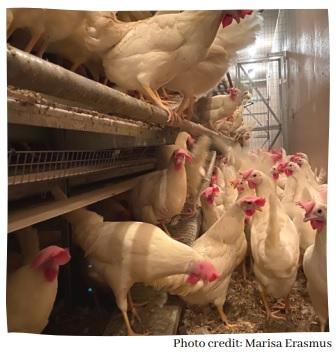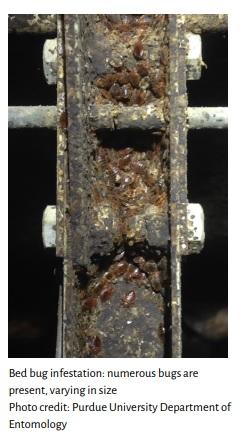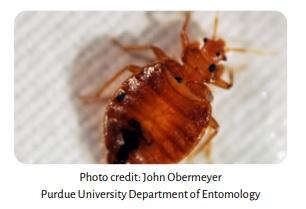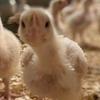Poultry Parasites: Bed Bugs



- Bed bugs are temporary parasites, meaning that they only spend part of their life cycle on the host, which includes mammals and birds, including humans, bats, chickens, and many others
- Bed bugs are obligate hematophagous (blood feeding) ectoparasites: their only source of food is blood, they live outside of their host (ectoparasite) and they repeatedly feed on the same host
- Bed bugs are nocturnal, and come out at night to feed when their host is mostly inactive
- Thankfully, bed bugs are flightless!
- It takes an adult bed bug between 5 and 20 minutes to complete a meal; bed bugs typically return to their resting spot within 30 minutes after feeding
- If adult bed bugs have access to abundant food, they will feed about once or twice a week
- Mature female bed bugs start laying eggs within 2 to 5 days after a meal and can lay between 200 and 500 eggs in a lifetime
- Bed bugs communicate through pheromones: they secrete alarm pheromone when distressed, which can cause other bed bugs to disperse from that area; and aggregation pheromone which attracts other bed bugs to an area
- Bed bugs can find their hosts from a distance of 1.5 m (4.9 ft) by detecting carbon dioxide (CO2) from breath, body heat, and possibly odors, but the science about odors is still inconclusive
- Normally, adult bed bugs can live for up to 2–4 months, but this depends on their environment

- Bed bugs are nocturnal and spend most of their time in their “harborages”, places where they hide close to their host, making them difficult to detect
- Bed bugs are resistant to many types of insecticides, which is especially problematic in places where animals are used to produce food for human consumption, such as in poultry houses
- Bed bugs can survive for a long time without food; adults can survive for several months and nymphs can survive for up to 70 days
- For poultry facilities, this means that the bugs can stay in their harborages where they are very difficult to find and eradicate during periods when there are no poultry in the facility
- The more complex the housing environment, the more difficult it is to detect and find bed bugs
- If conditions are optimal and females lay lots of eggs, the bed bug population can double in size every 13–16 days depending on environmental conditions and availability of blood (food) source
- Rashes or signs of bites may not always be an indicator of a bed bug infestation, because it can be difficult to distinguish between bed bug bites and bites from other insects
- Often, body parts that are not covered by clothes, such as the arms and face, are locations of bed bug bites
- Bites can occur in a linear pattern and cause wheals (red, swollen areas)
- Not all people develop reactions to, or symptoms of, bed bug bites
- For most people who develop symptoms, this occurs within one to two days after being bitten, but it can take as long as 9 to 10 days for symptoms to develop
- People who react to bed bug bites may develop the following
- For people that are bitten, finding bed bugs is the surest evidence of an infestation and cause of bites and rashes
- It can take over a week for the bitten area to heal, or longer if there is a more severe reaction to the bite
- Mental health impacts, including stress, anxiety and depression associated with having an infestation and physical reactions to being bitten
- Relationship conflict and social isolation
- The costs associated with exterminating bed bugs, which can include the extermination costs, loss of furniture and equipment within the affected area, and the inability to use the area while extermination is taking place, among other costs
- Skin reactions and lesions(sores), but these can be difficult to see
- Anemia (blood loss)
- In breeder and egg facilities, bed bugs can cause a decrease in egg production
- If the infestation is severe enough, it can result in death of the birds
- Economic losses due to lost productivity and extermination costs
- Because bed bugs are nocturnal, small and flat, they squeeze into small cracks and crevices during the day, making them hard to see
- Bed bugs sometimes leave dark brown fecal spots and smudges in areas where they feed
- If the infestation level is high, you may even see groups of bugs varying in size and life stages, along with their empty shells that they shed when they molt between or within life stages, and fecal spots, as seen in the image to the right
- Look for bed bugs in cracks, crevices, floor joints, where other structures join together, where the floor and wall meet and in electrical receptacles. In human dwellings, bed bugs can be found in mattress seams, bed frames, sofas, chairs, and wooden furniture, in addition to the places mentioned previously


- Training and education
- Early identification of infestations
- Control interventions
- Continued monitoring

- Vacuuming them up
- Sealing up and removing parts of the facility, such as pieces of furniture
- Using Climbup® interceptors to trap bed bugs, but these traps may not be useful inside barns
- Using high temperatures (close to 50℃; 122°F) for 4 hours, or lower temperatures (45-48℃; 113-118°F) but for a longer period of 6-8 hours. It is recommended to rely on licensed and insured pest management companies to implement bed bug heat treatments.
- Bed bugs can also be killed by exposing them to cold temperatures(-20℃; -4°F for 2 days or -15 to -18℃; 5 to -0.4°F for 3.5 days), but this may be difficult to do
- A Cryonite® machine, which creates dry ice (-110°F) from carbon dioxide can be used to instantly freeze bed bugs. While this is a useful control method for low level or recent bed bug introductions, it is not feasible to use Cryonite for large bed bug infestations
- A problem with using chemical methods is that bed bugs are resistant to some chemicals, and in particular, pyrethroids (synthetic insecticides)
- Depending on the facility that the bed bugs are in, some chemicals may not be permitted and/or may be toxic to humans and other animals
- In general, chemical methods that can be applied include
- For poultry facilities, pest management options differ depending on whether poultry are present or the facility is empty.
- If the facility is empty, all bed bugs can be killed if the inside of the facility can be heated such that bed bug harborages reach a temperature of > 50 ℃ (> 122°F); however, the effects of heat on different components of the poultry facility and possible resulting damage need to be considered.
- Using diatomaceous earth may be helpful, but the amount used and possible effects on poultry present in the facility need to be considered, and diatomaceous earth cannot reach all of the areas where bed bugs harbor.
- Certain pesticides can be used when the birds are housed in the barns, whereas some others can be used only when the facility is empty. To prevent pesticide misuse, product label directions should be followed meticulously. Because of the common occurrence of pesticide resistance in bed bugs, the use of pesticides should always be combined with other non-chemical control measures (i.e. integrated pest management plan should be adopted).
- Industrial grade bleach and Virkon, which are used in poultry houses as disinfectants can kill bed bugs within a few minutes of direct contact, but dried residues of these products are not effective. As such, the use of bleach and Virkonwill not completely eliminate bed bugs.
- Any chemical application should be done when ventilation is good because chemicals can be irritating or toxic to any animals or humans within the facility.
Anonymous, n.d. Bed bugs. Purdue University Medical Entomology. Available online: https://extension.entm.purdue.edu/publichealth/insects/bedbug.html
Bennett, G.W., A.D. Gondhalekar, C. Wang, G. Buczkowski, and T.J. Gibb. 2015. Using research and education to implement practical bed bug control programsin multifamily housing. Pest. Manag. Sci. 72: 8-14. Available online: https://www.extension.entm.purdue.edu/bedbugs/pdf/Bennett_et_al-2016-Pest_Management_Science.pdf
Cranshaw, W.S., m. Camper, and F.B. Peairs. 2013. Bat bugs, bed bugs and relatives. Colorado State University Extension. Available online: https://extension.colostate.edu/topic-areas/insects/bat-bugs-bed-bugs-andrelatives-5-574/
Dill, J.F., and C.A. Kirby. Bed bugs. Pest management factsheet #5004. University of Maine Cooperative Extension. Available online: https://extension.umaine.edu/ipm/ipddl/publications/5004e/
Evision, S.E.F., W.T.Hentley, R. Wilson and M.T. Siva-Jothy. 2018. Bed bug biology. In: Advancesin the biology and management of modern bed bugs. Doggett, S.L., D.M. Miller, and C. Lee (eds.). John Wiley&Sons, Inc.Hoboken, N.J. pp 109-114.
Hahn, J. and S. Kells. 2021. Bed bugs. University of Minnesota Extension. Available online: https://extension.umn.edu/biting-insects/bed-bugs
Hill, C.A., and J.F. MacDonald. 2010. Bed bugs: biology and public health risk. Purdue University Extension. Available online: https://extension.entm.purdue.edu/publications/E-249.pdf
Hwang, S.J.E., S.L. Doggett, and P. Fernandez-Penas. 2018. Dermatology and immunology. In: Advances in the biology and management of modern bed bugs. Doggett, S.L., D.M. Miller, and C. Lee (eds.). John Wiley&Sons, Inc.Hoboken,N.J. pp 109-114.
Jacobs, S. 2015. Bed bugs. PennState Extension. Available online: https://extension.psu.edu/bed-bugs
Miller, D.M. 2018. The bed bug resurgence inNorth America. In: Advancesin the biology and management of modern bed bugs. Doggett, S.L., D.M. Miller, and C. Lee (eds.). John Wiley&Sons, Inc.Hoboken,N.J. pp 45-48.
Miller, D.M. and A. Polanco.N.d. Bed bug biology and behavior. Virginia Tech University Extension. Available online: https://www.vdacs.virginia.gov/pdf/bb-biology1.pdf
Mullens, B. and A. Murillo. 2018. The future of poultry pest management. In: Advancesin poultrywelfare. Mench, J.A. (ed.). Woodhead Publishing, Cambridge, MA.
Polanco, A.M., C.C. Brewster, and D.M. Miller. 2011. Population Growth Potential of the Bed Bug, Cimex lectularius L.: A Life Table Analysis. Insects. 2:173-185. https://doi.org/10.3390/insects2020173
Potter, M.F. 2020. Bed bugs. University of Kentucky Entomology. Available online: https://entomology.ca.uky.edu/ef636
S.L. Doggett. 2018. Miscellaneous health impacts. In: Advancesin the biology and management of modern bed bugs. Doggett, S.L., D.M. Miller, and C. Lee (eds.). John Wiley&Sons, Inc.Hoboken,N.J. pp 133-136.
Tabler, T., K.M. Loftin, and J. Wells. 2018. Combatting bed bugsin broiler breeder houses. Mississippi State University Extension. Available online: http://extension.msstate.edu/sites/default/files/publications/publications/p3293.pdf
Waldvogel, M., P. Alder, and C. Apperson. 2018. Bedbugs – biology and control.NC State Extension. Available online: https://content.ces.ncsu.edu/bedbugs-biology-and-control













.jpg&w=3840&q=75)